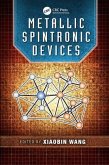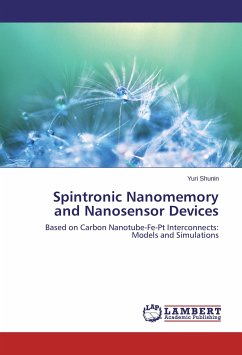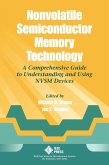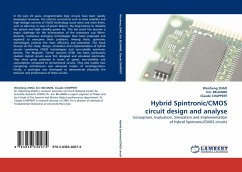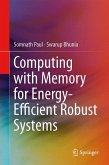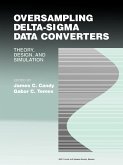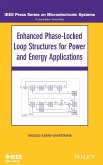Jayasimha Atulasimha, Supriyo Bandyopadhyay
Nanomagnetic and Spintronic Devices for Energy-Efficient Memory and Computing
Jayasimha Atulasimha, Supriyo Bandyopadhyay
Nanomagnetic and Spintronic Devices for Energy-Efficient Memory and Computing
- Gebundenes Buch
- Merkliste
- Auf die Merkliste
- Bewerten Bewerten
- Teilen
- Produkt teilen
- Produkterinnerung
- Produkterinnerung
Nanomagnetic and spintronic computing devices are strong contenders for future replacements of CMOS. This is an important and rapidly evolving area with the semiconductor industry investing significantly in the study of nanomagnetic phenomena and in developing strategies to pinpoint and regulate nanomagnetic reliably with a high degree of energy efficiency. This timely book explores the recent and on-going research into nanomagnetic-based technology. Key features: * Detailed background material and comprehensive descriptions of the current state-of-the-art research on each topic. * Focuses on…mehr
Andere Kunden interessierten sich auch für
![Metallic Spintronic Devices Metallic Spintronic Devices]() Metallic Spintronic Devices137,99 €
Metallic Spintronic Devices137,99 €![Spintronic Nanomemory and Nanosensor Devices Spintronic Nanomemory and Nanosensor Devices]() Yuri ShuninSpintronic Nanomemory and Nanosensor Devices15,99 €
Yuri ShuninSpintronic Nanomemory and Nanosensor Devices15,99 €![Nonvolatile Semiconductor Memory Technology Nonvolatile Semiconductor Memory Technology]() Nonvolatile Semiconductor Memory Technology281,99 €
Nonvolatile Semiconductor Memory Technology281,99 €![Hybrid Spintronic/CMOS circuit design and analyse Hybrid Spintronic/CMOS circuit design and analyse]() Weisheng ZhaoHybrid Spintronic/CMOS circuit design and analyse53,99 €
Weisheng ZhaoHybrid Spintronic/CMOS circuit design and analyse53,99 €![Computing with Memory for Energy-Efficient Robust Systems Computing with Memory for Energy-Efficient Robust Systems]() Somnath PaulComputing with Memory for Energy-Efficient Robust Systems85,99 €
Somnath PaulComputing with Memory for Energy-Efficient Robust Systems85,99 €![Oversampling Delta-SIGMA Data Converters Oversampling Delta-SIGMA Data Converters]() Oversampling Delta-SIGMA Data Converters280,99 €
Oversampling Delta-SIGMA Data Converters280,99 €![Enhanced Phase-Locked Loop Structures for Power and Energy Applications Enhanced Phase-Locked Loop Structures for Power and Energy Applications]() Masoud Karimi-GhartemaEnhanced Phase-Locked Loop Structures for Power and Energy Applications140,99 €
Masoud Karimi-GhartemaEnhanced Phase-Locked Loop Structures for Power and Energy Applications140,99 €-
-
-
Nanomagnetic and spintronic computing devices are strong contenders for future replacements of CMOS. This is an important and rapidly evolving area with the semiconductor industry investing significantly in the study of nanomagnetic phenomena and in developing strategies to pinpoint and regulate nanomagnetic reliably with a high degree of energy efficiency. This timely book explores the recent and on-going research into nanomagnetic-based technology. Key features: * Detailed background material and comprehensive descriptions of the current state-of-the-art research on each topic. * Focuses on direct applications to devices that have potential to replace CMOS devices for computing applications such as memory, logic and higher order information processing. * Discusses spin-based devices where the spin degree of freedom of charge carriers are exploited for device operation and ultimately information processing. * Describes magnet switching methodologies to minimize energy dissipation. * Comprehensive bibliographies included for each chapter enabling readers to conduct further research in this field. Written by internationally recognized experts, this book provides an overview of a rapidly burgeoning field for electronic device engineers, field-based applied physicists, material scientists and nanotechnologists. Furthermore, its clear and concise form equips readers with the basic understanding required to comprehend the present stage of development and to be able to contribute to future development. Nanomagnetic and Spintronic Devices for Energy-Efficient Memory and Computing is also an indispensable resource for students and researchers interested in computer hardware, device physics and circuits design.
Hinweis: Dieser Artikel kann nur an eine deutsche Lieferadresse ausgeliefert werden.
Hinweis: Dieser Artikel kann nur an eine deutsche Lieferadresse ausgeliefert werden.
Produktdetails
- Produktdetails
- Verlag: Wiley
- Seitenzahl: 352
- Erscheinungstermin: 7. März 2016
- Englisch
- Abmessung: 246mm x 168mm x 23mm
- Gewicht: 862g
- ISBN-13: 9781118869260
- ISBN-10: 1118869265
- Artikelnr.: 42487397
- Herstellerkennzeichnung
- Libri GmbH
- Europaallee 1
- 36244 Bad Hersfeld
- gpsr@libri.de
- Verlag: Wiley
- Seitenzahl: 352
- Erscheinungstermin: 7. März 2016
- Englisch
- Abmessung: 246mm x 168mm x 23mm
- Gewicht: 862g
- ISBN-13: 9781118869260
- ISBN-10: 1118869265
- Artikelnr.: 42487397
- Herstellerkennzeichnung
- Libri GmbH
- Europaallee 1
- 36244 Bad Hersfeld
- gpsr@libri.de
Professor Supriyo Bandyopadhyay, Virginia Commonwealth University, Virginia, USA Supriyo Bandyopadhyay is Commonwealth Professor of Electrical and Computer Engineering at Virginia Commonwealth University where he directs the Quantum Device Laboratory. Prof. Bandyopadhyay has authored and co-authored over 300 research publications and he is currently a member of the editorial board of seven international journals. He is the current Chair of the Institute of Electrical and Electronics Engineers (IEEE) Technical Committee on Spintronics (Nanotechnology Council), and past-chair of the Technical Committee on Compound Semiconductor Devices and Circuits (Electron Device Society). He has been an IEEE Electron Device Society Distinguished Lecturer and served as a Vice President of the IEEE Nanotechnology Council. Prof. Bandyopadhyay is a Fellow of the Institute of Electrical and Electronics Engineers, the Institute of Physics, American Physical Society, the Electrochemical Society and the American Association for the Advancement of Science. Professor Jayasimha Atulasimha, Virginia Commonwealth University, Virginia, USA Jayasimha Atulasimha is Qimonda Associate Professor of Mechanical and Nuclear Engineering with a courtesy appointment in Electrical and Computer Engineering at the Virginia Commonwealth University, where he directs the Magnetism, Magnetic Materials and Magnetic Devices (M3) laboratory. He has authored or coauthored over 60 scientific articles including more than 40 journal publications on magnetostrictive materials, magnetization dynamics, and nanomagnetic computing and has given several invited talks at conferences, workshops and universities in the USA and abroad on these topics. His research interests include nanomagnetism, spintronics, magnetostrictive materials and nanomagnet-based computing devices. He received the NSF CAREER Award for 2013-2018. He currently serves on the Technical Committees for Spintronics, IEEE Nanotechnology Council, ASME Adaptive Structures and Material Systems, Device Research Conference (DRC), and as a Focus Topic organizer for the APS topical group on magnetism (GMAG). He is a member of ASME, APS and an IEEE Senior Member.
About the Editors and Acknowledgments xi List of Contributors xiii Foreword xvii Preface xix 1 Introduction to Spintronic and Nanomagnetic Computing Devices 1 Jayasimha Atulasimha and Supriyo Bandyopadhyay 1.1 Spintronic Devices 1 1.2 Nanomagnetic Devices 3 1.2.1 Use of Spin Torque to Switch Nanomagnets 6 1.2.2 Other Methodologies for Switching Nanomagnets 6 1.3 Thinking beyond Traditional Boolean Logic 7 References 7 2 Potential Applications of all Electric Spin Valves Made of Asymmetrically Biased Quantum Point Contacts 9 Nikhil Bhandari, Maitreya Dutta, James Charles, Junjun Wan, Marc Cahay, and S.T Herbert 2.1 Introduction 9 2.2 Quantum Point Contacts 11 2.3 Spin Orbit Coupling 14 2.3.1 Rashba SOC (RSOC) 15 2.3.2 Dresselhaus SOC (DSOC) 15 2.3.3 Lateral Spin-Orbit Coupling (LSOC) 16 2.4 Importance of Spin Relaxation in 1D Channels 18 2.5 Observation of a 0.5 Conductance Plateau in Asymmetrically Biased QPCs in the Presence of LSOC 20 2.5.1 Early Experimental Results Using InAs QPCs 20 2.5.2 NEGF Conductance Calculations 20 2.5.3 Spin Texture Associated with Conductance Anomalies in QPCs 23 2.5.4 Prospect for Generation of Spin Polarized Current at Higher Temperature 25 2.5.5 Observation of Other Anomalous Conductance Plateaus in an Asymmetrically Biased InAs/In0.52 Al0.48 as QPCs 26 2.6 Intrinsic Bistability near Conductance Anomalies 27 2.6.1 Experimental Results 28 2.6.2 NEGF Simulations 30 2.7 QPC Structures with Four In-plane SGs: Toward an All Electrical Spin Valve 43 2.7.1 Preliminary Results on Four-gate QPCs 43 2.7.2 Experiments 46 2.7.3 Onset of Hysteresis and Negative Resistance Region 50 2.8 Future Work 56 2.9 Summary 58 Acknowledgments 60 References 60 3 Spin-Transistor Technology for Spintronics/CMOS Hybrid Logic Circuits and Systems 65 Satoshi Sugahara, Yusuke Shuto, and Shuu'ichirou Yamamoto 3.1 Spin-Transistor and Pseudo-Spin-Transistor 65 3.1.1 Spin - MOSFET 66 3.1.2 Pseudo-Spin-MOSFET 69 3.2 Energy-Efficient Logic Applications of Spin-Transistors 72 3.2.1 Power Gating with Nonvolatile Retention 73 3.2.2 Nonvolatile Bistable Circuits 75 3.2.3 Break-even Time 76 3.3 Nonvolatile SRAM Technology 78 3.3.1 Static Noise Margin of Nonvolatile SRAM 79 3.3.2 Energy Performance of NV-SRAM 81 3.4 Application of Nonvolatile Bistable Circuits for Memory Systems 86 References 88 4 Spin Transfer Torque: A Multiscale Picture 91 Yunkun Xie, Ivan Rungger, Kamaram Munira, Maria Stamenova, Stefano Sanvito, and Avik W. Ghosh 4.1 Introduction 91 4.1.1 Background 91 4.1.2 STT Modeling: An Integrated Approach 93 4.2 The Physics of Spin Transfer Torque 94 4.2.1 Free-Electron Model for Magnetic Tunnel Junction 96 4.3 First Principles Evaluation of TMR and STT 102 4.3.1 The TMR Effect in the MgO Barrier 104 4.3.2 Currents and Torques in NEGF 114 4.3.3 First Principles Results on Spin Transfer Torque 116 4.4 Magnetization Dynamics 119 4.4.1 Landau-Lifshitz-Gilbert Equation 119 4.4.2 Spin Torque Switching in Presence of Thermal Fluctuations 121 4.4.3 Including Thermal Fluctuations: Stochastic LLG vs Fokker Planck 122 4.5 Summary: Multiscaling from Atomic Structure to Error Rate 125 Acknowledgments 129 References 129 5 Magnetic Tunnel Junction Based Integrated Logics and Computational Circuits 133 Jian-Ping Wang, Mahdi Jamali, Angeline Klemm Smith, and Zhengyang Zhao 5.1 Introduction 133 5.2 GMR Based Field Programmable Devices 134 5.3 MTJ Based Field Programmable Devices 136 5.3.1 MTJ Structure and TMR Ratio 136 5.3.2 MTJ Based Magneto-Logic 137 5.3.3 Utilization of STT in MTJ Based Magneto-Logic 144 5.4 Information Transformation between Gates 145 5.4.1 Direct Communication Using Charge Current 146 5.4.2 Magnetic Domain Walls for Information Transferring 148 5.5 MTJ Based Logic-in-Memory Devices 148 5.6 Magnetic Quantum Cellular Automata 149 5.6.1 Introduction and Background 149 5.6.2 Experimental Demonstrations 150 5.7 All-Spin Based Magnetic Logic 155 5.7.1 Nonlocal Lateral Spin Valve Background 155 5.7.2 Critical Parameters for Operation 155 5.7.3 Selected Review of Experimental Demonstrations 156 5.7.4 Applications to All-Spin Logic Devices 158 5.8 Summary 161 Acknowledgment 161 References 162 6 Magnetization Switching and Domain Wall Motion Due to Spin Orbit Torque 165 Debanjan Bhowmik, OukJae Lee, Long You, and Sayeef Salahuddin 6.1 Introduction 165 6.2 Theory 166 6.2.1 Rashba Effect 168 6.2.2 Spin Hall Effect 169 6.3 Magnetic Switching Driven by Spin Orbit Torque 171 6.4 Domain Wall Motion Driven by Spin Orbit Torque 176 6.5 Applications of Spin Orbit Torque 184 6.6 Conclusion 186 References 186 7 Magnonic Logic Devices 189 Alexander Khitun and Alexander Kozhanov 7.1 Introduction 189 7.2 Magnonic Logic Devices 197 7.3 Spin Wave-Based Logic Gates and Architectures 206 7.4 Discussion and Summary 212 References 216 8 Strain Mediated Magnetoelectric Memory 221 N. Tiercelin, Y. Dusch, S. Giordano, A. Klimov, V. Preobrazhensky, and P. Pernod 8.1 Introduction 221 8.2 Concept of Unequivocal Strain- or Stress-Switched Nanomagnetic Memory 223 8.2.1 Magnetic Configuration and Equilibrium Positions 223 8.2.2 Quasi-Static Stress-Mediated Switching 225 8.3 LLG Simulations - Macrospin Model 226 8.3.1 Landau-Lifshitz-Gilbert Equation and Effective Magnetic Field 226 8.3.2 Memory Parameters 227 8.3.3 Results of the Macrospin Model 228 8.4 LLG Simulations - Eshelby Approach 231 8.4.1 Geometry of the Memory Element 232 8.4.2 Coupling with the External Magnetic Field 233 8.4.3 Coupling with the External Electric Field and Elastic Stress 234 8.4.4 Static Behavior of the System 234 8.4.5 Dynamic Behavior of the System 235 8.5 Stochastic Error Analysis 238 8.5.1 Statistical Mechanics of Magnetization in a Single-Domain Particle 238 8.5.2 Switching Process within the Magnetoelectric Memory 243 8.6 Preliminary Experimental Results 248 8.6.1 Piezoelectric Actuator with in-Plane Polarization 248 8.6.2 Ferroelectric Relaxors with out-of-Plane Polarization 249 8.6.3 Magnetoelastic Switching in a Magneto-Resistive Structure 250 8.7 Conclusions 250 Acknowledgments 252 References 253 9 Hybrid Spintronics-Strainronics 259 Ayan K. Biswas, Noel D'Souza, Supriyo Bandyopadhyay, and Jayasimha Atulasimha 9.1 Introduction 259 9.1.1 Nanomagnetic Memory and Logic Devices: The Problem of Energy Dissipation in the Clocking Circuit 260 9.1.2 Switching Nanomagnets with Strain Could Drastically Reduce Energy Dissipation: Hybrid Spintronics-Straintronics Overview 261 9.1.3 Landau Lifshitz Gilbert (LLG) Equation 263 9.2 Nanomagnetic Memory Switched with Strain 265 9.2.1 Complete Magnetization Reversal (180
Switching): Complex out-of-Plane Dynamics 265 >90
268 9.2.3 Complete 180
Switching with Stress Alone 269 9.2.4 Mixed Mode Switching of Magnetization by 180
: Acoustically Assisted Spin Transfer Torque (STT) Switching for Nonvolatile Memory 273 9.3 Straintronic Clocking of Nanomagnetic Logic 276 9.3.1 Two-State Dipole Coupled Nanomagnetic Logic 276 9.3.2 Four-state Multiferroic Nanomagnetic Logic (NML) 279 9.3.3 Switching Error in Dipole Coupled Nanomagnetic Logic (NML) 283 9.3.4 Straintronic Nanomagnetic Logic Devices (NML) 284 9.4 Summary and Conclusions 286 References 286 10 Unconventional Nanocomputing with Physical Wave Interference Functions 291 Santosh Khasanvis, Mostafizur Rahman, Prasad Shabadi, and Csaba Andras Moritz 10.1 Overview 291 10.2 Spin Waves Physical Layer for WIF Implementation 293 10.2.1 Physical Fabric Components 295 10.3 Elementary WIF Operators for Logic 298 10.4 Binary WIF Logic Design 303 10.4.1 Binary WIF Full Adder 303 10.4.2 Parallel Counters 306 10.4.3 Benchmarking Binary WIF Circuits vs. CMOS 309 10.4.4 WIF Topology Exploration 310 10.5 Multivalued WIF Logic Design 311 10.5.1 Multivalued Operators and Implementation Using WIF 312 10.5.2 Multivalued Arithmetic Circuit Example: Quaternary Full Adder 316 10.5.3 Benchmarking of WIF Multivalued Circuits vs. Conventional CMOS 318 10.5.4 Input/Output Logic for Data Conversion between Binary and Radix-r Domains 319 10.6 Microprocessors with WIF: Opportunities and Challenges 320 10.7 Summary and Future Work 326 References 326 Index 329 A color plate section falls between pages 44 and 45
Switching): Complex out-of-Plane Dynamics 265 >90
268 9.2.3 Complete 180
Switching with Stress Alone 269 9.2.4 Mixed Mode Switching of Magnetization by 180
: Acoustically Assisted Spin Transfer Torque (STT) Switching for Nonvolatile Memory 273 9.3 Straintronic Clocking of Nanomagnetic Logic 276 9.3.1 Two-State Dipole Coupled Nanomagnetic Logic 276 9.3.2 Four-state Multiferroic Nanomagnetic Logic (NML) 279 9.3.3 Switching Error in Dipole Coupled Nanomagnetic Logic (NML) 283 9.3.4 Straintronic Nanomagnetic Logic Devices (NML) 284 9.4 Summary and Conclusions 286 References 286 10 Unconventional Nanocomputing with Physical Wave Interference Functions 291 Santosh Khasanvis, Mostafizur Rahman, Prasad Shabadi, and Csaba Andras Moritz 10.1 Overview 291 10.2 Spin Waves Physical Layer for WIF Implementation 293 10.2.1 Physical Fabric Components 295 10.3 Elementary WIF Operators for Logic 298 10.4 Binary WIF Logic Design 303 10.4.1 Binary WIF Full Adder 303 10.4.2 Parallel Counters 306 10.4.3 Benchmarking Binary WIF Circuits vs. CMOS 309 10.4.4 WIF Topology Exploration 310 10.5 Multivalued WIF Logic Design 311 10.5.1 Multivalued Operators and Implementation Using WIF 312 10.5.2 Multivalued Arithmetic Circuit Example: Quaternary Full Adder 316 10.5.3 Benchmarking of WIF Multivalued Circuits vs. Conventional CMOS 318 10.5.4 Input/Output Logic for Data Conversion between Binary and Radix-r Domains 319 10.6 Microprocessors with WIF: Opportunities and Challenges 320 10.7 Summary and Future Work 326 References 326 Index 329 A color plate section falls between pages 44 and 45
About the Editors and Acknowledgments xi List of Contributors xiii Foreword xvii Preface xix 1 Introduction to Spintronic and Nanomagnetic Computing Devices 1 Jayasimha Atulasimha and Supriyo Bandyopadhyay 1.1 Spintronic Devices 1 1.2 Nanomagnetic Devices 3 1.2.1 Use of Spin Torque to Switch Nanomagnets 6 1.2.2 Other Methodologies for Switching Nanomagnets 6 1.3 Thinking beyond Traditional Boolean Logic 7 References 7 2 Potential Applications of all Electric Spin Valves Made of Asymmetrically Biased Quantum Point Contacts 9 Nikhil Bhandari, Maitreya Dutta, James Charles, Junjun Wan, Marc Cahay, and S.T Herbert 2.1 Introduction 9 2.2 Quantum Point Contacts 11 2.3 Spin Orbit Coupling 14 2.3.1 Rashba SOC (RSOC) 15 2.3.2 Dresselhaus SOC (DSOC) 15 2.3.3 Lateral Spin-Orbit Coupling (LSOC) 16 2.4 Importance of Spin Relaxation in 1D Channels 18 2.5 Observation of a 0.5 Conductance Plateau in Asymmetrically Biased QPCs in the Presence of LSOC 20 2.5.1 Early Experimental Results Using InAs QPCs 20 2.5.2 NEGF Conductance Calculations 20 2.5.3 Spin Texture Associated with Conductance Anomalies in QPCs 23 2.5.4 Prospect for Generation of Spin Polarized Current at Higher Temperature 25 2.5.5 Observation of Other Anomalous Conductance Plateaus in an Asymmetrically Biased InAs/In0.52 Al0.48 as QPCs 26 2.6 Intrinsic Bistability near Conductance Anomalies 27 2.6.1 Experimental Results 28 2.6.2 NEGF Simulations 30 2.7 QPC Structures with Four In-plane SGs: Toward an All Electrical Spin Valve 43 2.7.1 Preliminary Results on Four-gate QPCs 43 2.7.2 Experiments 46 2.7.3 Onset of Hysteresis and Negative Resistance Region 50 2.8 Future Work 56 2.9 Summary 58 Acknowledgments 60 References 60 3 Spin-Transistor Technology for Spintronics/CMOS Hybrid Logic Circuits and Systems 65 Satoshi Sugahara, Yusuke Shuto, and Shuu'ichirou Yamamoto 3.1 Spin-Transistor and Pseudo-Spin-Transistor 65 3.1.1 Spin - MOSFET 66 3.1.2 Pseudo-Spin-MOSFET 69 3.2 Energy-Efficient Logic Applications of Spin-Transistors 72 3.2.1 Power Gating with Nonvolatile Retention 73 3.2.2 Nonvolatile Bistable Circuits 75 3.2.3 Break-even Time 76 3.3 Nonvolatile SRAM Technology 78 3.3.1 Static Noise Margin of Nonvolatile SRAM 79 3.3.2 Energy Performance of NV-SRAM 81 3.4 Application of Nonvolatile Bistable Circuits for Memory Systems 86 References 88 4 Spin Transfer Torque: A Multiscale Picture 91 Yunkun Xie, Ivan Rungger, Kamaram Munira, Maria Stamenova, Stefano Sanvito, and Avik W. Ghosh 4.1 Introduction 91 4.1.1 Background 91 4.1.2 STT Modeling: An Integrated Approach 93 4.2 The Physics of Spin Transfer Torque 94 4.2.1 Free-Electron Model for Magnetic Tunnel Junction 96 4.3 First Principles Evaluation of TMR and STT 102 4.3.1 The TMR Effect in the MgO Barrier 104 4.3.2 Currents and Torques in NEGF 114 4.3.3 First Principles Results on Spin Transfer Torque 116 4.4 Magnetization Dynamics 119 4.4.1 Landau-Lifshitz-Gilbert Equation 119 4.4.2 Spin Torque Switching in Presence of Thermal Fluctuations 121 4.4.3 Including Thermal Fluctuations: Stochastic LLG vs Fokker Planck 122 4.5 Summary: Multiscaling from Atomic Structure to Error Rate 125 Acknowledgments 129 References 129 5 Magnetic Tunnel Junction Based Integrated Logics and Computational Circuits 133 Jian-Ping Wang, Mahdi Jamali, Angeline Klemm Smith, and Zhengyang Zhao 5.1 Introduction 133 5.2 GMR Based Field Programmable Devices 134 5.3 MTJ Based Field Programmable Devices 136 5.3.1 MTJ Structure and TMR Ratio 136 5.3.2 MTJ Based Magneto-Logic 137 5.3.3 Utilization of STT in MTJ Based Magneto-Logic 144 5.4 Information Transformation between Gates 145 5.4.1 Direct Communication Using Charge Current 146 5.4.2 Magnetic Domain Walls for Information Transferring 148 5.5 MTJ Based Logic-in-Memory Devices 148 5.6 Magnetic Quantum Cellular Automata 149 5.6.1 Introduction and Background 149 5.6.2 Experimental Demonstrations 150 5.7 All-Spin Based Magnetic Logic 155 5.7.1 Nonlocal Lateral Spin Valve Background 155 5.7.2 Critical Parameters for Operation 155 5.7.3 Selected Review of Experimental Demonstrations 156 5.7.4 Applications to All-Spin Logic Devices 158 5.8 Summary 161 Acknowledgment 161 References 162 6 Magnetization Switching and Domain Wall Motion Due to Spin Orbit Torque 165 Debanjan Bhowmik, OukJae Lee, Long You, and Sayeef Salahuddin 6.1 Introduction 165 6.2 Theory 166 6.2.1 Rashba Effect 168 6.2.2 Spin Hall Effect 169 6.3 Magnetic Switching Driven by Spin Orbit Torque 171 6.4 Domain Wall Motion Driven by Spin Orbit Torque 176 6.5 Applications of Spin Orbit Torque 184 6.6 Conclusion 186 References 186 7 Magnonic Logic Devices 189 Alexander Khitun and Alexander Kozhanov 7.1 Introduction 189 7.2 Magnonic Logic Devices 197 7.3 Spin Wave-Based Logic Gates and Architectures 206 7.4 Discussion and Summary 212 References 216 8 Strain Mediated Magnetoelectric Memory 221 N. Tiercelin, Y. Dusch, S. Giordano, A. Klimov, V. Preobrazhensky, and P. Pernod 8.1 Introduction 221 8.2 Concept of Unequivocal Strain- or Stress-Switched Nanomagnetic Memory 223 8.2.1 Magnetic Configuration and Equilibrium Positions 223 8.2.2 Quasi-Static Stress-Mediated Switching 225 8.3 LLG Simulations - Macrospin Model 226 8.3.1 Landau-Lifshitz-Gilbert Equation and Effective Magnetic Field 226 8.3.2 Memory Parameters 227 8.3.3 Results of the Macrospin Model 228 8.4 LLG Simulations - Eshelby Approach 231 8.4.1 Geometry of the Memory Element 232 8.4.2 Coupling with the External Magnetic Field 233 8.4.3 Coupling with the External Electric Field and Elastic Stress 234 8.4.4 Static Behavior of the System 234 8.4.5 Dynamic Behavior of the System 235 8.5 Stochastic Error Analysis 238 8.5.1 Statistical Mechanics of Magnetization in a Single-Domain Particle 238 8.5.2 Switching Process within the Magnetoelectric Memory 243 8.6 Preliminary Experimental Results 248 8.6.1 Piezoelectric Actuator with in-Plane Polarization 248 8.6.2 Ferroelectric Relaxors with out-of-Plane Polarization 249 8.6.3 Magnetoelastic Switching in a Magneto-Resistive Structure 250 8.7 Conclusions 250 Acknowledgments 252 References 253 9 Hybrid Spintronics-Strainronics 259 Ayan K. Biswas, Noel D'Souza, Supriyo Bandyopadhyay, and Jayasimha Atulasimha 9.1 Introduction 259 9.1.1 Nanomagnetic Memory and Logic Devices: The Problem of Energy Dissipation in the Clocking Circuit 260 9.1.2 Switching Nanomagnets with Strain Could Drastically Reduce Energy Dissipation: Hybrid Spintronics-Straintronics Overview 261 9.1.3 Landau Lifshitz Gilbert (LLG) Equation 263 9.2 Nanomagnetic Memory Switched with Strain 265 9.2.1 Complete Magnetization Reversal (180
Switching): Complex out-of-Plane Dynamics 265 >90
268 9.2.3 Complete 180
Switching with Stress Alone 269 9.2.4 Mixed Mode Switching of Magnetization by 180
: Acoustically Assisted Spin Transfer Torque (STT) Switching for Nonvolatile Memory 273 9.3 Straintronic Clocking of Nanomagnetic Logic 276 9.3.1 Two-State Dipole Coupled Nanomagnetic Logic 276 9.3.2 Four-state Multiferroic Nanomagnetic Logic (NML) 279 9.3.3 Switching Error in Dipole Coupled Nanomagnetic Logic (NML) 283 9.3.4 Straintronic Nanomagnetic Logic Devices (NML) 284 9.4 Summary and Conclusions 286 References 286 10 Unconventional Nanocomputing with Physical Wave Interference Functions 291 Santosh Khasanvis, Mostafizur Rahman, Prasad Shabadi, and Csaba Andras Moritz 10.1 Overview 291 10.2 Spin Waves Physical Layer for WIF Implementation 293 10.2.1 Physical Fabric Components 295 10.3 Elementary WIF Operators for Logic 298 10.4 Binary WIF Logic Design 303 10.4.1 Binary WIF Full Adder 303 10.4.2 Parallel Counters 306 10.4.3 Benchmarking Binary WIF Circuits vs. CMOS 309 10.4.4 WIF Topology Exploration 310 10.5 Multivalued WIF Logic Design 311 10.5.1 Multivalued Operators and Implementation Using WIF 312 10.5.2 Multivalued Arithmetic Circuit Example: Quaternary Full Adder 316 10.5.3 Benchmarking of WIF Multivalued Circuits vs. Conventional CMOS 318 10.5.4 Input/Output Logic for Data Conversion between Binary and Radix-r Domains 319 10.6 Microprocessors with WIF: Opportunities and Challenges 320 10.7 Summary and Future Work 326 References 326 Index 329 A color plate section falls between pages 44 and 45
Switching): Complex out-of-Plane Dynamics 265 >90
268 9.2.3 Complete 180
Switching with Stress Alone 269 9.2.4 Mixed Mode Switching of Magnetization by 180
: Acoustically Assisted Spin Transfer Torque (STT) Switching for Nonvolatile Memory 273 9.3 Straintronic Clocking of Nanomagnetic Logic 276 9.3.1 Two-State Dipole Coupled Nanomagnetic Logic 276 9.3.2 Four-state Multiferroic Nanomagnetic Logic (NML) 279 9.3.3 Switching Error in Dipole Coupled Nanomagnetic Logic (NML) 283 9.3.4 Straintronic Nanomagnetic Logic Devices (NML) 284 9.4 Summary and Conclusions 286 References 286 10 Unconventional Nanocomputing with Physical Wave Interference Functions 291 Santosh Khasanvis, Mostafizur Rahman, Prasad Shabadi, and Csaba Andras Moritz 10.1 Overview 291 10.2 Spin Waves Physical Layer for WIF Implementation 293 10.2.1 Physical Fabric Components 295 10.3 Elementary WIF Operators for Logic 298 10.4 Binary WIF Logic Design 303 10.4.1 Binary WIF Full Adder 303 10.4.2 Parallel Counters 306 10.4.3 Benchmarking Binary WIF Circuits vs. CMOS 309 10.4.4 WIF Topology Exploration 310 10.5 Multivalued WIF Logic Design 311 10.5.1 Multivalued Operators and Implementation Using WIF 312 10.5.2 Multivalued Arithmetic Circuit Example: Quaternary Full Adder 316 10.5.3 Benchmarking of WIF Multivalued Circuits vs. Conventional CMOS 318 10.5.4 Input/Output Logic for Data Conversion between Binary and Radix-r Domains 319 10.6 Microprocessors with WIF: Opportunities and Challenges 320 10.7 Summary and Future Work 326 References 326 Index 329 A color plate section falls between pages 44 and 45


